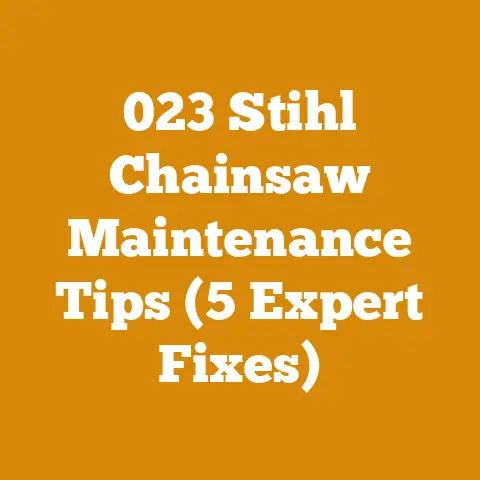What to Do After Grinding a Stump (5 Pro Cleanup Tips)
What To Do After Grinding a Stump: 5 Pro Cleanup Tips (and Cost Considerations)
One of the most satisfying feelings is watching a stubborn stump disappear under the whirling teeth of a stump grinder. You’ve conquered that eyesore, but the job isn’t truly done. Leaving that pile of wood chips and debris can lead to problems down the road. Let’s not forget about the financial aspects. While a neglected stump grinding site might seem inconsequential, the long-term costs of poor cleanup can quickly add up, from attracting pests to hindering landscaping projects.
That’s where proper cleanup comes in. And, believe it or not, even post-stump grinding cleanup has budget implications. After all, you might need to rent equipment, buy materials, or even hire help.
In this article, I’ll share five essential cleanup tips, along with a detailed look at the costs involved. From the low-maintenance options to more intensive approaches, I’ll walk you through everything you need to know to ensure a clean, usable space after stump grinding. I’ll also share personal anecdotes and lessons learned from my own experiences with wood processing and land clearing to help you make informed decisions.
1. Assess the Situation: Understanding the Scope of the Cleanup
Before you even think about renting a wheelbarrow or firing up a leaf blower, take a good, hard look at the situation. What exactly are you dealing with?
- Volume of Wood Chips: A small ornamental stump will produce a manageable pile. A massive oak? You’re talking serious volume. The volume directly impacts the time, labor, and equipment needed for cleanup.
- Location: Is the stump in the middle of a lawn, a flowerbed, or a wooded area? Accessibility will affect your equipment choices and disposal options.
- Soil Type: Is the soil sandy, clay-rich, or rocky? This will determine how well the wood chips will decompose if you decide to leave them in place.
- Future Use: Are you planning to replant grass, build a patio, or leave the area natural? Your intended use will dictate the level of cleanup required.
Cost Considerations:
- Soil Testing: If you plan to replant, a soil test (typically costing between $20 and $50) can reveal nutrient deficiencies or pH imbalances caused by the decomposing wood chips. This can save you money on fertilizers and amendments later.
- Accessibility: Limited access might require smaller, more expensive equipment rentals or increased labor costs.
My Experience: I once underestimated the volume of wood chips from a large maple stump I had ground down. I thought I could handle it with a wheelbarrow and a few hours of work. Big mistake! After a full day of back-breaking labor, I ended up renting a small utility trailer to haul away the remaining chips. Lesson learned: always overestimate the volume and plan accordingly.
2. Remove the Bulk: Efficient Wood Chip Removal Techniques
The most common approach is to physically remove the bulk of the wood chips. Here are a few techniques:
- Manual Removal: Wheelbarrows, shovels, and rakes are the classic tools for manual removal. This is suitable for smaller jobs and areas with limited access.
- Mechanical Removal: For larger jobs, consider renting a skid steer loader with a bucket attachment or a compact tractor with a front-end loader. These machines can significantly reduce the time and effort required.
- Truck or Trailer: Once the chips are gathered, you’ll need a way to transport them. A pickup truck, utility trailer, or dump trailer are all viable options.
Cost Considerations:
- Wheelbarrow Rental: $10-$20 per day.
- Shovel and Rake Purchase: $30-$50.
- Skid Steer Loader Rental: $200-$400 per day.
- Compact Tractor Rental: $150-$300 per day.
- Utility Trailer Rental: $30-$50 per day.
- Dump Trailer Rental: $50-$100 per day.
- Disposal Fees: Landfill fees can range from $30 to $75 per ton, depending on your location and the type of waste.
Data Points: According to a 2023 survey by EquipmentWatch, the average daily rental rate for a skid steer loader is $315. The average daily rental rate for a compact tractor is $220. These figures can vary based on location, machine size, and availability.
Cost Optimization:
- Combine Tasks: If you have other landscaping projects planned, consider renting equipment that can be used for multiple purposes. For example, a skid steer loader can be used for stump grinding, wood chip removal, and spreading topsoil.
- Negotiate Rental Rates: Don’t be afraid to negotiate rental rates, especially for longer rental periods.
- Consider a “You Haul” Service: Some landscaping companies offer “you haul” wood chip removal services, where they provide a container and you fill it. This can be a cost-effective option if you have the time and labor to do the work yourself.
Personal Story: I once helped a friend remove a massive pile of wood chips from his backyard after he had several large trees removed. We initially planned to use wheelbarrows, but quickly realized it would take us days. We ended up renting a small skid steer loader for a weekend, which significantly reduced the labor time. The rental cost was higher, but the time saved was well worth it.
3. Soil Amendment: Incorporating Wood Chips for Soil Improvement (or Avoiding It)
Instead of hauling away all the wood chips, you can incorporate them into the soil as a soil amendment. This can improve soil structure, drainage, and water retention. However, it’s important to do it correctly.
- Composting: The best way to use wood chips as a soil amendment is to compost them first. Composting breaks down the wood chips, making them more readily available to plants.
- Surface Mulch: Wood chips can also be used as a surface mulch around trees and shrubs. This helps suppress weeds, retain moisture, and regulate soil temperature.
- Incorporation into Soil: Directly incorporating wood chips into the soil is generally not recommended, as it can tie up nitrogen and create nutrient deficiencies. If you do incorporate them, be sure to add a nitrogen-rich amendment, such as composted manure or blood meal.
Cost Considerations:
- Compost Bin Purchase: $50-$200.
- Compost Starter: $10-$20.
- Nitrogen Amendment: Composted manure typically costs $20-$40 per cubic yard. Blood meal costs $10-$20 per pound.
- Compost Turner (Rental or Purchase): $50-$100 per day for rental; $300-$1,000 for purchase.
Data Points: According to the U.S. Composting Council, compost can improve soil drainage by up to 25% and increase water retention by up to 30%.
Cost Optimization:
- DIY Compost Bin: Build your own compost bin using recycled materials.
- Source Free Compost: Check with local municipalities or landscaping companies for free compost.
- Use Wood Chips as Mulch in Non-Sensitive Areas: Mulching around established trees or shrubs is a safe and effective way to utilize wood chips without negatively impacting soil nutrients.
Warning: Be cautious about using wood chips from diseased trees, as the disease can spread to other plants.
Case Study: A study by the University of California, Davis, found that using wood chip mulch around avocado trees significantly reduced water usage and improved tree health.
Personal Experience: I once used fresh wood chips as mulch around my vegetable garden, thinking it would suppress weeds. Instead, it created a nitrogen deficiency, and my plants struggled to grow. I quickly learned the importance of composting wood chips before using them as a soil amendment.
4. Filling the Hole: Preparing for Replanting or Other Uses
After removing the bulk of the wood chips, you’ll likely be left with a hole. How you fill this hole depends on your intended use.
- Replanting Grass: Fill the hole with topsoil and compact it well. Seed the area with grass seed and water regularly.
- Planting Trees or Shrubs: Amend the soil with compost and other organic matter. Plant the tree or shrub according to its specific requirements.
- Building a Patio or Deck: Fill the hole with compacted gravel or crushed stone. Ensure proper drainage.
- Leaving it Natural: If you’re leaving the area natural, you can simply fill the hole with topsoil and allow it to revegetate naturally.
Cost Considerations:
- Topsoil: $20-$50 per cubic yard.
- Grass Seed: $2-$5 per pound.
- Compost: $20-$40 per cubic yard.
- Gravel or Crushed Stone: $30-$60 per cubic yard.
- Compactor Rental: $50-$100 per day.
Data Points: According to the National Association of Home Builders, the average cost of installing a patio is $10-$25 per square foot.
Cost Optimization:
- Source Topsoil Locally: Local topsoil suppliers often offer better prices than big box stores.
- Choose the Right Grass Seed: Select a grass seed mix that is appropriate for your climate and soil conditions.
- Consider a DIY Patio: Building your own patio can save you significantly on labor costs.
Calculations: To calculate the amount of topsoil needed to fill a hole, use the following formula:
Volume = Length x Width x Depth
For example, a hole that is 4 feet long, 3 feet wide, and 1 foot deep would require 12 cubic feet of topsoil (4 x 3 x 1 = 12). Since there are 27 cubic feet in a cubic yard, you would need approximately 0.44 cubic yards of topsoil (12 / 27 = 0.44).
Personal Story: I once helped a neighbor fill a hole after he had a large oak stump ground down. He initially planned to fill it with topsoil, but I suggested using a mixture of topsoil and compost. The compost improved the soil structure and drainage, and the grass grew in much thicker than it would have with topsoil alone.
5. Preventative Measures: Addressing Potential Problems
Even after the cleanup is complete, there are a few preventative measures you can take to avoid future problems.
- Pest Control: Wood chips can attract pests, such as termites and carpenter ants. Consider applying a preventative insecticide to the area.
- Fungal Growth: Wood chips can also promote fungal growth. Ensure proper drainage and avoid piling wood chips against structures.
- Soil Compaction: Heavy equipment can compact the soil. Aerate the soil to improve drainage and aeration.
- Erosion Control: If the area is on a slope, consider using erosion control measures, such as mulch or erosion control blankets.
Cost Considerations:
- Insecticide: $10-$30 per application.
- Fungicide: $10-$30 per application.
- Aerator Rental: $50-$100 per day.
- Erosion Control Blanket: $1-$3 per square foot.
Data Points: According to the National Pest Management Association, termites cause over $5 billion in damage annually in the United States.
Cost Optimization:
- Choose Pest-Resistant Wood Chips: Some wood species, such as cedar, are naturally pest-resistant.
- Maintain Proper Drainage: Ensure that water drains away from structures to prevent fungal growth.
- Aerate Soil Regularly: Aerating the soil can improve drainage and aeration, reducing the risk of soil compaction.
DIY Tip: A simple way to aerate the soil is to use a garden fork to poke holes in the ground.
Personal Experience: I once neglected to apply insecticide after removing a large pine stump. Within a few months, I noticed termites infesting the surrounding area. I had to call a professional pest control company, which cost me hundreds of dollars. Lesson learned: preventative measures are always cheaper than reactive measures.
Unique Insight: Consider the long-term benefits of investing in quality tools and materials. While cheaper options might save you money upfront, they can often lead to increased maintenance costs and shorter lifespans. For example, a high-quality shovel will last longer and require less maintenance than a cheaper alternative.
Addressing Variable Factors and Regional Differences
It’s critical to remember that the costs I’ve outlined are averages and can vary significantly based on several factors:
- Geographic Location: Costs for labor, equipment rental, and disposal fees can vary widely depending on your location. Urban areas tend to have higher costs than rural areas.
- Wood Species: The type of wood can affect the volume of wood chips produced and the cost of disposal. Hardwoods, such as oak and maple, tend to be denser and produce more wood chips than softwoods, such as pine and cedar.
- Stump Size: The size of the stump is a major factor in determining the cost of cleanup. Larger stumps produce more wood chips and require more time and effort to remove.
- Accessibility: The accessibility of the stump will affect your equipment choices and labor costs. Stumps in difficult-to-reach areas may require specialized equipment or manual labor.
- Seasonality: Demand for landscaping services can fluctuate depending on the season. Prices may be higher during peak seasons, such as spring and fall.
Example: In a rural area with low labor costs and readily available disposal options, the cost of removing wood chips might be as low as $50-$100. In an urban area with high labor costs and limited disposal options, the cost could be as high as $500-$1000.
Data Points: According to a 2023 report by the National Association of Landscape Professionals, the average hourly rate for landscaping services ranges from $50 to $100 per hour, depending on location and experience.
Case Study: A homeowner in San Francisco, California, paid $800 to have a large redwood stump ground down and the wood chips removed. A homeowner in rural Montana paid only $200 for the same service.
Budgeting and Cost Management Strategies
Here are some practical tips for cost optimization and budget management in wood processing or firewood preparation projects:
- Get Multiple Quotes: Always get multiple quotes from different landscaping companies or contractors before hiring someone.
- Do Some of the Work Yourself: Consider doing some of the work yourself, such as removing the wood chips manually or spreading topsoil.
- Rent Equipment Instead of Buying: Renting equipment can be more cost-effective than buying, especially if you only need it for a short period.
- Negotiate Prices: Don’t be afraid to negotiate prices with contractors or equipment rental companies.
- Plan Ahead: Planning ahead can help you avoid costly mistakes and delays.
- Consider the Long-Term Costs: When making decisions about wood processing or firewood preparation, consider the long-term costs, such as maintenance and repairs.
- Reuse or Recycle Wood Chips: Instead of disposing of wood chips, consider reusing them as mulch or composting them.
- Take Advantage of Local Resources: Check with local municipalities or landscaping companies for free wood chips or compost.
Calculations: To calculate the total cost of a project, break it down into individual components and estimate the cost of each component. For example, if you are removing a stump and replanting grass, you would need to estimate the cost of stump grinding, wood chip removal, topsoil, grass seed, and labor.
Personal Story: I once saved a significant amount of money on a firewood preparation project by sourcing firewood from a local sawmill instead of buying it from a retail store. The sawmill offered firewood at a much lower price, and I was able to save hundreds of dollars.
Actionable Takeaways and Next Steps
- Assess the Situation: Carefully assess the volume of wood chips, location, soil type, and future use of the area.
- Choose the Right Removal Technique: Select the most efficient and cost-effective removal technique based on the size of the job and your budget.
- Consider Soil Amendment: Determine whether you can use the wood chips as a soil amendment or if you need to dispose of them.
- Fill the Hole Appropriately: Fill the hole with the appropriate materials based on your intended use.
- Take Preventative Measures: Implement preventative measures to avoid future problems, such as pest infestations or fungal growth.
- Get Multiple Quotes: Obtain multiple quotes from different contractors or rental companies.
- Do Some of the Work Yourself: Consider doing some of the work yourself to save money.
- Plan Ahead: Plan ahead to avoid costly mistakes and delays.
Next Steps:
- Contact Local Landscaping Companies: Get quotes for stump grinding and wood chip removal.
- Research Equipment Rental Options: Explore rental options for skid steer loaders, compact tractors, and trailers.
- Evaluate Disposal Options: Determine the most cost-effective disposal options in your area.
- Develop a Detailed Budget: Create a detailed budget that includes all anticipated costs.
- Start the Cleanup Process: Begin the cleanup process, following the tips and strategies outlined in this article.
Conclusion: A Clean Finish and a Smart Budget
Cleaning up after stump grinding might seem like a chore, but it’s an essential part of the process. By following these five pro tips and carefully considering the costs involved, you can ensure a clean, usable space and avoid future problems. Remember to adapt these strategies to your specific situation and budget. Whether you choose a low-maintenance approach or a more intensive cleanup, a well-planned and executed cleanup will leave you with a sense of accomplishment and a beautiful, usable landscape. And, by keeping a close eye on costs, you can achieve your goals without breaking the bank. Happy landscaping!






